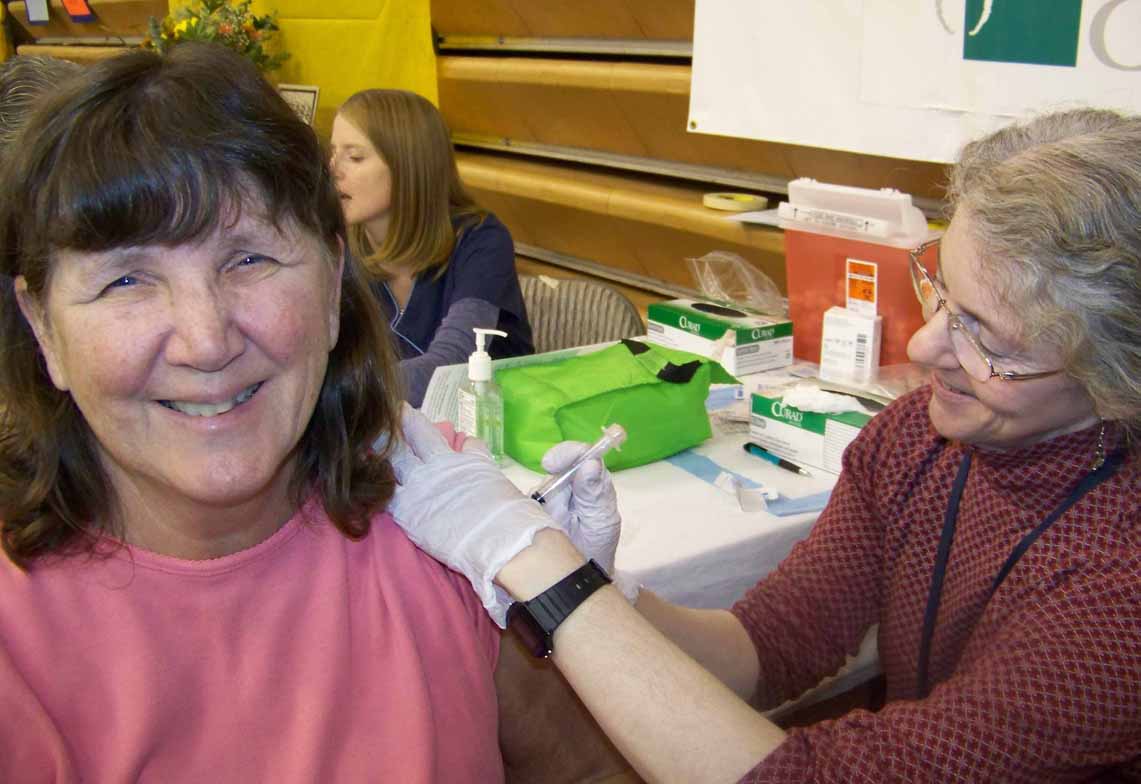While the theme of Saturday’s Rotary Health Fair is “It’s Your Life — Take a Day to Be Well,” it also could be “Take a Minute to Save a Life.”
At a new booth this year, Dr. Carl Seger, a board certified emergency physician, and South Peninsula Hospital will be offering emergency training in using automatic external defibrillators, or AEDs, the machines sometimes seen in public places like schools and restaurants. AEDs analyze a cardiac-arrest victim’s heart rhythm and, if needed, give a shock, or defibrillation, that resets the heart’s natural rhythm.
“AEDs are a key link to the chain of survival for patients who have had a cardiac arrest,” Dr. Seger said.
Homer Volunteer Fire Department Chief Bob Painter said there have been a half-dozen uses of AEDs this year that have saved lives.
One such save, Ginger VanWagoner, calls herself a walking miracle. She had the bad luck to go into cardiac arrest, but the good luck for it to happen in a public place with people trained in CPR and an AED that got there within minutes.
VanWagoner, 64, and her husband, Steve VanWagoner, were celebrating their 45th wedding anniversary at AJ’s Old Town Steakhouse and Tavern. Ginger VanWagoner danced to “Celebration,” by Kool and the Gang, while her husband played with the band, “Elders on Fire.” That’s the last thing she remembered for four days.
Talking to friends and her husband, VanWagoner learned that she’d collapsed on the dance floor. Dr. Rene Alvarez and Alaska State Parks Ranger Roger MacCampbell, both trained in cardiopulmonary resuscitation, were at the party. MacCampbell got to her first and started CPR. MacCampbell gave VanWagoner breaths while Dr. Alvarez, a surgeon, did chest compressions.
“My sternum definitely felt like it had been hit by crow bar,” she said.
A bystander, Alan Olson, called 911. Adrienne Sweeney, the owner of AJ’s, knew St. John the Baptist Catholic Church had an AED and started to go get it, but Homer Police Officer David Sheely responded within minutes with one of the AEDs carried in police cars. All Homer police officers have training in using AEDs, said Homer Police Chief Mark Robl, and the department has enough AEDs so that each patrol officer on duty has one in his car.
Public AEDs are easy to use, Painter said. You turn it on, apply pads to the victim’s chest and the AED analyzes the heart rhythms. The heart is an electromechanical pump where the blood flow through the heart’s four chambers is regulated by electrical impulses — a natural pacemaker, he said. AEDs shock two kinds of abnormal heart rhythms, ventricular fibrillation and ventricular tachycardia.
Ventricular fibrillation is where the heart’s electrical activity becomes chaotic and the heart can’t pump blood effectively. Ventricular tachycardia is where the heart beats too fast and the heart doesn’t empty and fill properly.
“The idea there is you shock the heart into resetting that pacemaker site, the natural pacemaker site in the heart, and let it take over,” Painter said.
That’s what happened with VanWagoner: the AED got her heart rhythm reset. Alvarez kept doing chest compressions.
“He wasn’t going to give up his post,” VanWagoner said of Alvarez.
Shortly after Sheely came with the AED, HVFD medics in an ambulance and started advanced life support with oxygen and heart drugs. VanWagoner went to South Peninsula Hospital for more treatment, a cardiac scan and to be stabilized. Eventually she and her husband flew to Alaska Regional Hospital on a medevac plane. VanWagoner now has her own personal AED, an implantable cardioverter defibrillator, or ICD, placed under the skin in her chest. She also has an electronic pacemaker to reset the heart’s rhythm if the ICD goes off.
That combination of CPR and an AED saved VanWagoner’s life — and her brain, she said.
“Early defibrillation and good CPR are almost the only proven care that not only increases survival, but survival with a meaningful neurologic outcome,” Seger said.
VanWagoner said she later learned from doctors that she was one of the 5 percent of heart attack victims who not only live, but the 1 percent who survive and don’t have brain damage.
“It was because they were able to get to me quickly,” she said.
After VanWagoner’s heart attack, AJ’s got an AED. A friend of VanWagoner, Diane McBride, got an AED for her lodge, Kachemak Bay Wilderness Lodge. The city of Homer has AEDs at Homer City Hall, at Public Works, the Homer Public Library and the Harbormaster’s Office. The Kachemak Emergency Services Firefighters Association recently got a $7,000 grant to buy four more AEDs. McNeil Canyon Elementary School, Razdolna School, Voznesenka School and Kachemak Selo School all have AEDs. KES volunteer emergency medical technicians also have AEDs in their cars, and once more AEDs are purchased, they’ll go into other public places, said KES Chief Bob Cicciarella.
Getting AEDs into the community is something Dr. Seger and SPH are encouraging.
“Evidence is mounting that placement of AEDs in the community that is educated in how to use them results in better survival to hospital discharge for patients who have suffered a cardiac arrest,” Dr. Seger said.
CPR classes now teach people how to use AEDs, Painter said.
“When we teach CPR, one of the things we teach people to do is, call 911, get me an AED,” he said. “That chain of survival, the basic chain of survival, is early defibrillation and care at the ER.”


